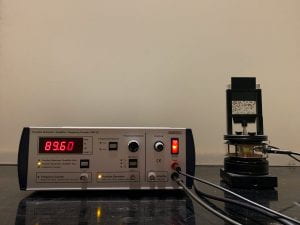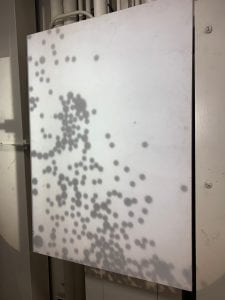This demonstrates the kinetic motion of molecules within a substance. There are two versions of this demo. Version 1 is able to demonstrate how pressure works with molecular motion. However, Version 2 is much more effective for larger classrooms, but requires fine adjustment.
Version 1: The Mechanical Vibrator drives a vertical paddle up and down at a frequency set by the function generator. This piston pushes the steel balls up and down, causing them to vibrate. This demonstrates the motion of the molecules in a substance as its kinetic energy is increased.
Version 2: This Molecular Motion Model demonstrates the randomized interactions of molecules within a substance. This can model how temperature radiates through a solid, liquid or gas. More steel balls can be added to the apparatus to demonstrate a denser material.
Version 1:
Equipment:
- Molecular motion apparatus – D4
- Mechanical Vibrator – E4
- Fredrikson Function Generator (Model 2502.50)
- 2x banana cables
Instructions:
- Plug in and set up the function generator with two banana cables
- Plug the vertical paddle into the center of the mechanical vibrator
- Attach the banana cables to the mechanical vibrator and secure the base of the molecular motion apparatus to the top of the mechanical vibrator
- Drop the square plastic piece into the top to add an effective ‘pressure’ to the balls
- Drive the function generator between 0 and 1kHz
Version 2:
Equipment:
- Overhead Projector – Cupboard under circle saw
- Molecular Motion Apparatus – D4
- Variac
- Level / iPhone
Instructions:
- Plug in the projector and the Variac. Place the molecular motion apparatus on top of the the projector as show in Figure 2 and 3.
- Level it by twisting the screws on each corner of the apparatus and using a level or the one built into the ‘Measure’ app on your smartphone.
- Once it is level, switch on the projector and the Variac, plug the Variac into the molecular motion apparatus then increase the voltage on the Variac.
- It will drive the circular motor which drives the arm to scatter the steel balls and show how energy excites molecules in a substance.
- You may need to focus the projector on the board by using the knob at the top and by moving the whole projector to get a clear image.
Explanation:
The average transnational kinetic energy of molecules (metal balls) in random motion in an ideal gas is directly proportional to the absolute temperature of the gas (frequency of vibration). As the frequency increases, the balls will gain more kinetic energy.
This is derived from the ideal gas law:
and the kinetic theory of molecules,
Equating the two gives,
Letting
Gives,
This shows that kinetic energy is directly proportional to the temperature of a system. This demo is a physical representation of a closed system of N molecules (represented by steel balls) at a changing temperature T (frequency of driving paddle).
Note:
- The device should be angled so that when at rest the balls will settle along the metal plate. Also, it should be leveled so the “molecules” are equally distributed along the plate.
- A camera will be required for most large classrooms (Version 1)
Written by Phoenix Gallagher


